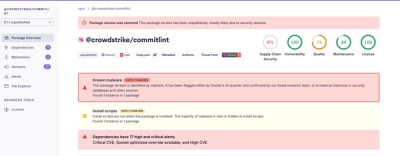
Research
Malicious fezbox npm Package Steals Browser Passwords from Cookies via Innovative QR Code Steganographic Technique
A malicious package uses a QR code as steganography in an innovative technique.
Aspose.SVG for Python via .NET enables creating, editing, rendering, and converting SVGs to formats like PNG, PDF, and more, excelling in image vectorization. Perfect for developing SVG tools.
Product Page | Docs | Demos | API Reference | Examples | Blog | Search | Free Support
Aspose.SVG for Python via .NET is a powerful on-premise class library designed to seamlessly work with SVG files in a wide range of operations without the need for additional SVG manipulation tools. It allows you to create, edit, optimize, and convert SVG. Python API allows you to manipulate documents and elements and provides robust navigation and inspection functionalities, such as XPath queries and CSS selectors. Developers can also vectorize images and texts, apply SVG transformations, filters, gradients, and patterns, and specify colors in different color formats. Aspose.SVG for Python via .NET supports both Windows and Unix platforms, making it perfectly suited for building applications such as SVG editors, converters, mergers, and image vectorizers catering to developers who require extensive SVG processing capabilities.
The following are some popular features of Aspose.SVG for Python via .NET:
| Format | Description | Load | Save |
|---|---|---|---|
| SVG | Scalable Vector Graphics Format | ✔️ | ✔️ |
| SVGZ | Compressed version of SVG | ✔️ | ✔️ |
| Portable Document Format | ✔️ | ||
| XPS | XML Paper Specification | ✔️ | |
| TIFF | Tagged Image File Format | ✔️ | |
| BMP | Bitmap Image File Format | ✔️ | |
| PNG | Portable Network Graphics | ✔️ | |
| JPEG | Joint Photographic Expert Group | ✔️ | |
| GIF | Graphical Interchange Format | ✔️ |
Aspose.SVG for Python via .NET is currently supported on Windows for developing applications where Python 3.6 or later is installed. You can build both 32-bit and 64-bit Python applications. Support for Linux and macOS X is planned for future versions.
Ready to give Aspose.SVG for Python via .NET a try?
Simply run pip install aspose-svg-net from the Console to fetch the package.
If you already have Aspose.SVG for Python via .NET and want to upgrade the version, please run pip install --upgrade aspose-svg-net to get the latest version.
You can run the following snippets in your environment to see how Aspose.SVG works, or check out the GitHub Repository or Aspose.SVG for Python via .NET Documentation for other common use cases.
You can create SVG from a string content using SVGDocument(content, base_uri) constructor:
from aspose.svg import SVGDocument
documentContent = "<svg xmlns='http://www.w3.org/2000/svg'><circle cx='100' cy='100' r='40' stroke='#ff9390' stroke-width='4' fill='#FF7F50' /></svg>";
# Create a new SVG document
document = SVGDocument(documentContent, ".")
# Save the document
document.save("create-svg-from-string.svg")
Source - Create SVG File, Load and Read SVG in Python
Aspose.SVG for Python via .NET also allows you to convert SVG to PDF, XPS, PNG, JPEG, TIFF, WEBP, and other file formats. The following snippet demonstrates the conversion from SVG to PNG literally with a single line of code!
from aspose.svg.converters import Converter
from aspose.svg.saving import ImageSaveOptions
# Convert SVG to PNG
Converter.convert_svg("document.svg", ImageSaveOptions(), "result.png")
Source - Convert SVG to PNG
Aspose.SVG for Python via .NET also allows you to convert SVG to PDF, XPS, PNG, JPEG, TIFF, WEBP, and other file formats. The following snippet demonstrates the conversion from SVG to PNG literally with a single line of code!
from aspose.svg import SVGDocument
from aspose.svg.converters import Converter
from aspose.svg.rendering import SizingType
from aspose.svg.drawing import Resolution
from aspose.svg.saving import PdfSaveOptions
from aspose.pydrawing import Color
# Open the SVG file
with SVGDocument("document.svg") as document:
# Create PDF save options and customize them
options = PdfSaveOptions()
options.background_color = Color.from_argb(0, 255, 255, 255)
options.page_setup.sizing = SizingType.FIT_CONTENT
options.horizontal_resolution = Resolution.from_dots_per_inch(96.0)
options.vertical_resolution = Resolution.from_dots_per_inch(96.0)
options.jpeg_quality = 80
# Convert SVG to PDF
Converter.convert_svg(document, options, "document.pdf")
Source - Convert SVG to PDF
Aspose.SVG for Python via .NET also allows you can convert a raster image to vector graphic using default or custom configuration options. You will be able to apply custom settings to get the best result of the image-to-vector conversion and save the output SVG file to your computer. The following snippet demonstrates the image vectorization:
from aspose.svg.imagevectorization import BezierPathBuilder, ImageTraceSmoother, ImageVectorizer
# Set up Bezier path builder with smoothing and curve-fitting parameters
path_builder = BezierPathBuilder()
path_builder.trace_smoother = ImageTraceSmoother(2)
path_builder.error_threshold = 30.0
path_builder.max_iterations = 30
# Initialize the image vectorizer
vectorizer = ImageVectorizer()
vectorizer.configuration.path_builder = path_builder
vectorizer.configuration.colors_limit = 25
vectorizer.configuration.line_width = 1.0
# Vectorize the image
with vectorizer.vectorize("flower.jpg") as document:
document.save("flower.svg")
Source - Vectorizing Images
Product Page | Docs | Demos | API Reference | Examples | Blog | Search | Free Support | Temporary License
FAQs
Aspose.SVG for Python via .NET enables creating, editing, rendering, and converting SVGs to formats like PNG, PDF, and more, excelling in image vectorization. Perfect for developing SVG tools.
We found that aspose-svg-net demonstrated a healthy version release cadence and project activity because the last version was released less than a year ago. It has 2 open source maintainers collaborating on the project.
Did you know?

Socket for GitHub automatically highlights issues in each pull request and monitors the health of all your open source dependencies. Discover the contents of your packages and block harmful activity before you install or update your dependencies.

Research
A malicious package uses a QR code as steganography in an innovative technique.

Research
/Security News
Socket identified 80 fake candidates targeting engineering roles, including suspected North Korean operators, exposing the new reality of hiring as a security function.

Application Security
/Research
/Security News
Socket detected multiple compromised CrowdStrike npm packages, continuing the "Shai-Hulud" supply chain attack that has now impacted nearly 500 packages.